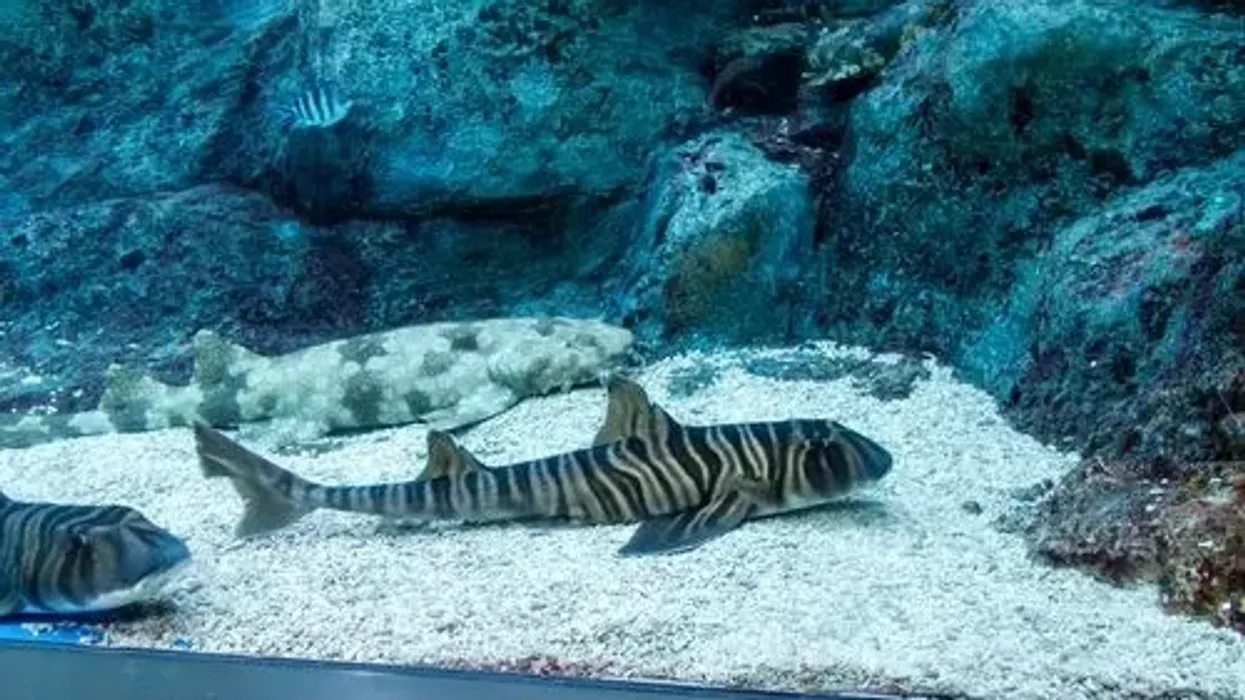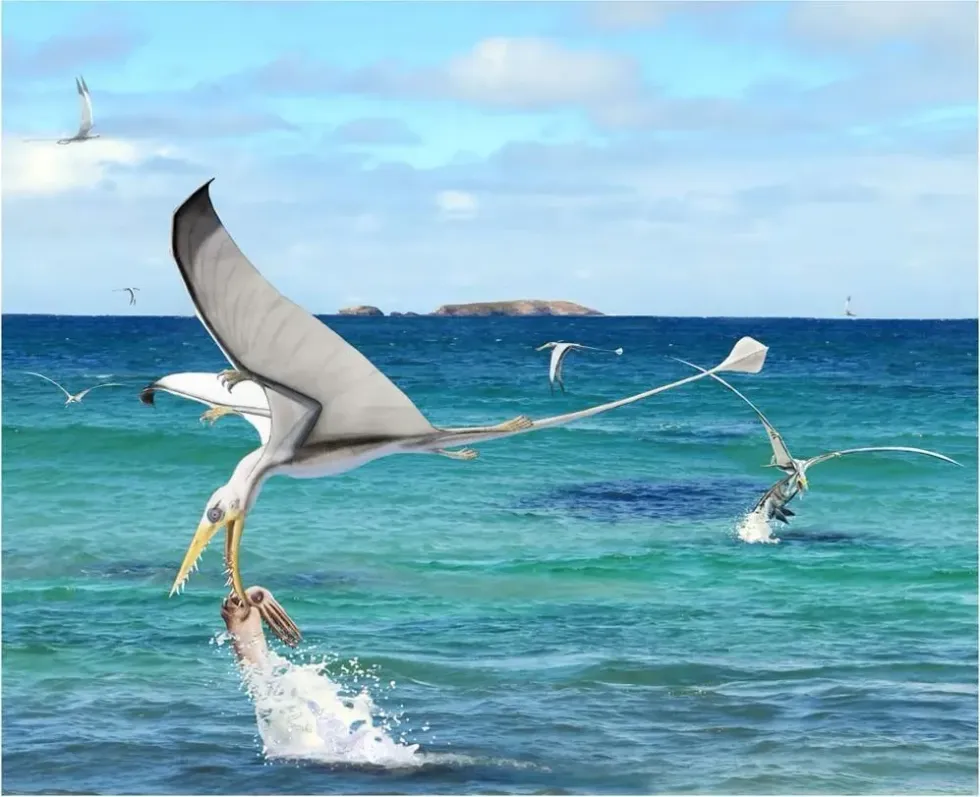The zebra bullhead shark (Heterodontus zebra) is a common but little-known bottom shark and one of the nine known living species of bullhead sharks of the world. They are members of the family Heterodontidae like the Port Jackson and the horn shark.
These oviparous sharks are known for their distinctive black/brown zebra-like stripes over a white background and, their blunt snout, square head, and stout body.
These are harmless and nocturnal sharks whose distribution normally dwells on the seafloor, usually on continental shelves. They can survive at depths from 164 ft (50 m) to 656 ft (200 m) below the surface of the sea.
They are endemic to the marine waters of the Western Central Pacific, the coast of Australia, and East Asian countries like Korea, Vietnam, China, Japan, and the Islands of Indonesia. Their distribution is towards the south of Wakayama Prefecture and is also known as the Japanese bullhead shark for this reason.
Check out Bonito fish and Rainbow trout for more facts.
Zebra Bullhead Shark Interesting Facts
What type of animal is a zebra bullhead shark?
Zebra bullhead shark (Heterodontus zebra) is a kind of bullhead shark which is a fish and belongs to the Heterodontidae family, genus heterodontus.
What class of animal does a zebra bullhead shark belong to?
Zebra bullhead shark (Heterodontus zebra) belongs to the Chondrichthyes class of the Animalia kingdom. They belong to the Heterodontidae family and heterodontus genus.
How many zebra bullhead sharks are there in the world?
The exact number of zebra bullhead sharks in the world is unknown. The conservation and distribution are in control at marine waters of Australia, Indonesia, Korea, Japan, and the western pacific. They are listed as Least Concern on the IUCN Red List of Threatened species.
Where does a zebra bullhead shark live?
Zebra bullhead shark dwells in the shallow waters of the western Pacific Ocean and the Indian Ocean, on the continental and insular shelves of eastern Asia (including countries like Korea, Japan, Vietnam, China, and Indonesia) the central Indo pacific and north western Australia.
What is a zebra bullhead shark's habitat?
Zebra bullhead shark habitat consists of reefs which are usually rocky and to sea bottom habitats. They use a wiggle movement and swim around shallow waters of the western pacific and in moderate depths of the continental and insular shelves.
It has also been observed at a depth range as deep as 164 ft (50 m). The fish can survive an environment with even deeper waters with depths ranging down to around 495-660 ft (150.8-201.16 m) in places like Australia. In Japan, it is distributed south of Wakayama Prefecture.
Who do zebra bullhead sharks live with?
They are usually known to swim alone but they do sometimes end up hunting fishes and invertebrates in groups.
How long does a zebra bullhead shark live?
The shark zebra bullhead is thought to live for 25 - 30 years.
How do they reproduce?
The reproduction of these species of shark is oviparous, unlike other sharks. Eggs are laid in egg cases that are spiral in shape.
Their biology shows that this spiral shape allows the egg cases to be wedged inside rock crevices, which prevents the attack from predators and protects the egg. Females lay two eggs simultaneously, during spring to late summer and this process is performed almost 6-12 times during the spawning season in Japan. The eggs hatch after a year.
Females lay up to two eggs at a time during spring to late summer. It takes around a year for the eggs to hatch and their length range from 0.5 ft-3.9 ft (18 -120 cm.)
During the process of courtship, males clutch the female shark by its pectoral fin and then wrap its body's posterior part beneath her. This position helps the males in the insertion of its clasper inside her cloaca.
What is their conservation status?
Zebra bullhead sharks are listed as the Least Concern on the IUCN Red List of threatened species. These species of fish are not prioritized by fisheries for commercial purposes but are often used as a bycatch during fishing.
Zebra Bullhead Shark Fun Facts
What do zebra bullhead sharks look like?

The body of these shark consists of a stout central body that is cylindrical in shape. It has a blunt snout and a large square-shaped head consisting of two sizeable protruded ridges above each eye.
Spiracles present behind the eyes help them to breathe. These shark species have two dorsal fins which are tall and consist of a prominent internal spine at their origin.
The first origin of the dorsal fin is located approximately at a level with the insertion of the pectoral fin. Similarly, the second origin of the dorsal fin is posterior to the free rear tip of the pelvic fin.
The pectoral fins are usually much larger than the first dorsal fin. The caudal fin is large and triangular consisting of a deep subterminal notch.
Their background body color range from white to beige with a pattern of vertical stripes that range from dark brown to black in color. Most bullhead shark zebra species have 12 vertical stripes on their bodies which gives them their name.
How cute are they?
They are not voracious as other sharks of the world and hence can come under the category of being cute for fish lovers. Their slow wiggly movements whilst swimming is adorable to look at. Zebra bullhead shark images are quite stunning.
How do they communicate?
The zebra bullhead shark species of the family Heterodontidae does not show any distinctive form of communication. They usually communicate by their motions, behavior, and body movements just like other sharks.
How big is a zebra bullhead shark?
They are 50 in (127 cm) in length. It is around four times bigger than a blobfish!
How fast can a zebra bullhead shark swim?
These shark species are said to be poor and slow swimmers among other sharks of the world. They are sluggish and slow in their movements.
How much does a zebra bullhead Shark weigh?
These species weigh around 55-88 lb (25-40 kg).
What are the male and female names of the species?
There are no distinguishable names given to males and females.
What would you call a baby zebra bullhead shark?
There is no name specified for a baby zebra bullhead fish.
What do they eat?
The biology and diet related to shark zebrafish species are little known. There is also little known information about what these sharks feed on. They tend to inhabit the habitat of reef rocks and ranges covered with kelp all along the coast. They are oviparous in nature.
These sharks tend to hide during the day and search for food at night. Their diet consists of all kinds of invertebrates, like crustaceans, and sea urchins, and also fish in their environment.
They also feed on meaty foods like shrimps, crabs, fish, and even mussels. These can be served fresh or frozen. The teeth are aptly designed to crush and grind the food that they consume.
Are they dangerous?
There is no known evidence in their biology to prove if the zebra bullhead shark species are dangerous to humans.
Would they make a good pet?
No, they would not be an appropriate option for a pet since they are used to inhibit in oceans and large water bodies. They also feed on sea creatures like shrimp, crabs, mollusks, and other small fishes which would be not easily available at homes.
However, they are displayed in many fisheries and aquariums and are a sight to behold.
Did you know...
These Least Concern species are said to show suction while eating and suck in their prey and water from inside the crevices of rocks in their habitat. This habit is prominent in other members of the Heterodontidae family like the Port Jackson shark and the horn shark in their environment.
They pierce and puncture their prey using their unique form of teeth. The sharp teeth of these oviparous species in the front help in tearing the prey and the flat molar-like teeth located at the sides and the back help in crushing and grinding the food like small fishes and other invertebrates.
How did zebra bullhead sharks get their name?
The word 'bullhead' in bullhead sharks comes due to their large and broadhead. The heavy brow bone present over each of the eyes gives them an appearance that resembles a bull. They possess a snout that is short and also a small mouth just like other members.
The zebra bullhead shark (Heterodontus zebra) gets their name from its striking color contrast. Their body is light brown to beige in color with numerous striking patterns of black to dark brown stripes which are somewhat reminiscent of a zebra.
What adaptations do zebra bullhead sharks have?
These shark species possess a small spiracle that is located behind and below each eye and is used for respiration. The large pectoral fins of these sharks are used to help them wiggle across rocky surfaces and the waterbed to search for food.
While hanging vertically, the pectoral fins also help them in holding onto the rocky surfaces inside the seabed.
They can stay motionless at the bottom of the seabed, or fisheries while breathing or eating at the same time just like the other members of the family Heterodontidae like the port Jackson and the horn shark.
Here at Kidadl, we have carefully created lots of interesting family-friendly animal facts for everyone to discover! For more relatable content, check out these Ocean Sunfish or Pilchard facts.
You can even occupy yourself at home by drawing one on our Fish coloring pages.
*The second image was taken by Jason Quinn









